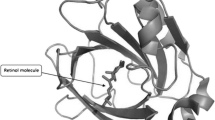Summary
Bacillus subtilis neutral proteinase was encapsulated in conventional dehydration-rehydration liposomes and, co-encapsulated with a phospholipase, in triggered liposomes. Triggered liposomes had released in buffer 58.0% of the encapsulated proteinase after 180 min at 30°C, whereas only 1.1% was released from conventional liposomes. Addition of triggered liposomes to milk resulted in only 70.4% residual β-casein after 240 min at 30°C compared to 90.7% in control milk. If triggered liposomes were added to milk with lactic starter and rennet, residual β-casein was only 52.3% after 240 min, compared to 80.3% in milk without liposomes.
Similar content being viewed by others
References
El Mayda, E., Pâquet, D., Ramet, J.P., and Linden, G. (1986). Proteolytic activity of a Bacillus subtilis neutral protease preparation upon caseins and whey proteins of cow's milk. J. Dairy Sci. 69, 305–310.
El Soda, M., Johnson, M., and Olson, N.F. (1989). Temperature sensitive liposomes: a controlled release system for the acceleration of cheese ripening. Milchwissenschaft 44, 213–214.
Kirby, C.J., and Gregoriadis, G. (1984). Dehydration-rehydration vesicles: a simple procedure for high drug entrapment in liposomes. Bio/Technol. 2, 979–984.
Kirby, C.J., Brooker, B.E., and Law, B.A. (1987). Accelerated ripening of cheese using liposome-encapsulated enzyme. Int. J. Food Sci. Technol. 22, 355–375.
Koide, K., and Karel, M. (1987). Encapsulation and stimulated release of enzymes using lecithin vesicles. Int. J. Food Sci. Technol. 22, 707–723.
Krupp, L., Chobanian, J.V., and Brecher, P.I. (1976). The in vivo transformation of phospholipid vesicles to a particle resembling HDL in the rat. Biochem. Biophys. Res. Comm. 72, 1251–1258.
Pahkala, E., Antila, V., and Laukkanen, M. (1984). Accelerating the ripening of cheese by the addition of proteolytic enzymes. I. The characteristics of the enzymes. Meijerit. Aikakauskirja 42, 1–20.
Picón, A., Gaya, P., Medina, M., and Nuñez, M. (1995). The effect of liposome-encapsulated Bacillus subtilis neutral proteinase on Manchego cheese ripening. J. Dairy Sci. 78, 1238–1247.
Skeie, S. (1994). Developments in microencapsulation science applicable to cheese research and development. A review. Int. Dairy J. 4, 573–595.
Stead, D. (1986). Microbial lipases: their characteristics, role in food spoilage and industrial uses. J. Dairy Res. 53, 481–505.
Author information
Authors and Affiliations
Rights and permissions
About this article
Cite this article
Picón, A., Gaya, P., Medina, M. et al. Release of encapsulated proteinase from dehydration-rehydration liposomes by a co-encapsulated phospholipase. Biotechnol Lett 17, 1051–1056 (1995). https://doi.org/10.1007/BF00143099
Issue Date:
DOI: https://doi.org/10.1007/BF00143099




